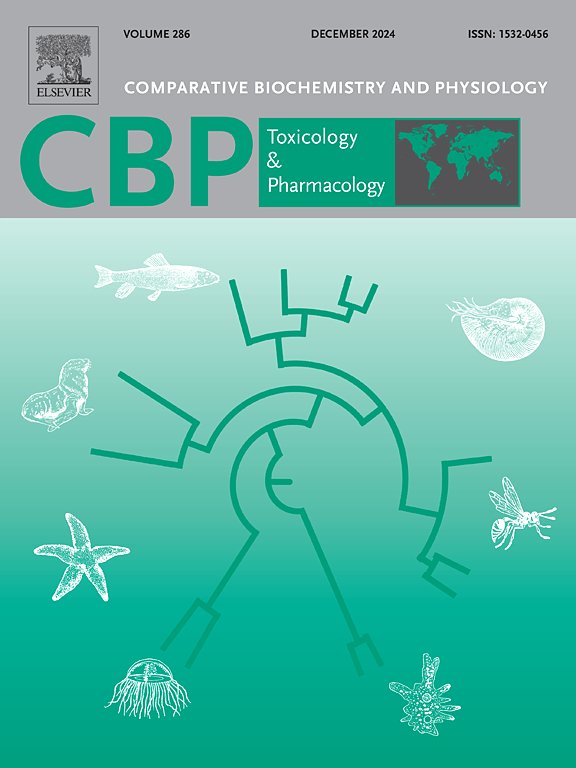Impacts of an environmental ototoxic pollutant on fish fighting behaviors
IF 4.3
3区 环境科学与生态学
Q2 BIOCHEMISTRY & MOLECULAR BIOLOGY
Comparative Biochemistry and Physiology C-toxicology & Pharmacology
Pub Date : 2024-12-07
DOI:10.1016/j.cbpc.2024.110103
引用次数: 0
Abstract
Numerous environmental pollutants exhibit ototoxicity and cause damage to the lateral line structures in fish, including the neuromast and its hair cells. The lateral line is used to detect hydrodynamic changes and is thought to play a significant role in aggressive interactions. Fighting behaviors in fish are crucial for establishing social hierarchy and obtaining limited resources. In this study, we ablated the function of hair cells using a commonly used ototoxin, neomycin, to evaluate the impact of this ototoxic pollutant on fighting behavior through damaging the lateral line. Our results showed that the number of wins and the duration of dyadic fight behavior decreased in zebrafish with lateral line ablation. These zebrafish also exhibited increased anxiety and biting frequencies. On the other hand, social preferences and fitness were not affected in lateral line-ablated zebrafish. In conclusion, the lateral line mechanosensory system is crucial for fish to gather sufficient information and make correct decisions during conflicts and fighting behaviors. Impairment of hair cell function can affect aggressive behaviors and decision-making in fish, subtly altering their behavioral patterns and leading to significant impacts on the aquatic ecosystem.

环境耳毒性污染物对鱼类战斗行为的影响。
许多环境污染物表现出耳毒性,并对鱼类的侧线结构造成损害,包括神经肥大及其毛细胞。侧线用于检测流体动力学变化,被认为在侵略性相互作用中起重要作用。鱼类的战斗行为对于建立社会等级和获取有限的资源至关重要。在这项研究中,我们使用一种常用的耳毒素新霉素消融毛细胞的功能,以评估这种耳毒性污染物通过破坏侧线对战斗行为的影响。我们的研究结果表明,斑马鱼在侧线消融后,获胜的次数和双矢战斗行为的持续时间减少。这些斑马鱼还表现出焦虑和咬人频率的增加。另一方面,斑马鱼的社会偏好和适应性不受侧线消融的影响。综上所述,侧线机械感觉系统对鱼类在冲突和战斗行为中收集足够的信息并做出正确的决策至关重要。毛细胞功能的损伤会影响鱼类的攻击行为和决策,微妙地改变它们的行为模式,对水生生态系统产生重大影响。
本文章由计算机程序翻译,如有差异,请以英文原文为准。
求助全文
约1分钟内获得全文
求助全文
来源期刊
CiteScore
7.50
自引率
5.10%
发文量
206
审稿时长
30 days
期刊介绍:
Part C: Toxicology and Pharmacology. This journal is concerned with chemical and drug action at different levels of organization, biotransformation of xenobiotics, mechanisms of toxicity, including reactive oxygen species and carcinogenesis, endocrine disruptors, natural products chemistry, and signal transduction with a molecular approach to these fields.

 求助内容:
求助内容: 应助结果提醒方式:
应助结果提醒方式:


